FLOW – daily features (2016)
Prompted by a 2014 tour through a missile launch site in the Everglades National Park, a woman reflects on the time when the Russian/Cuban/American nuclear standoff threatened to end life as we know it.
Valerie LeBlanc and Daniel H. Dugas
Soundmap: http://flow.basicbruegel.com/soundmap/
A mystery begins to form when a researcher finds uprooted plants on a Loop Road bridge. Tension mounts when a second car stops in that remote location.
Valerie LeBlanc and Daniel H. Dugas
Soundmap: http://flow.basicbruegel.com/soundmap/
There is one road that leads from the Everglades National Park entrance to Flamingo. There are no streets lights and at night, it is very dark.
Valerie LeBlanc and Daniel H. Dugas
Soundmap: http://flow.basicbruegel.com/soundmap/
The deer pen was built in July 1934. There are a few photographs depicting the area but little information exists on why it was built. Although it is located in the forest near a well-known trail, it is difficult to find.
Valerie LeBlanc and Daniel H. Dugas
Soundmap: http://flow.basicbruegel.com/soundmap/
Searching for a landmark in an overgrown setting, a woman is overcome by the atmosphere rising from the landscape.
Valerie LeBlanc and Daniel H. Dugas
Soundmap: http://flow.basicbruegel.com/soundmap/
Some people say that during the Cuban Missile Crisis, there were surveillance bunkers built along the Old Ingraham Road. Others deny the existence of such structures.
Valerie LeBlanc and Daniel H. Dugas
Soundmap: http://flow.basicbruegel.com/soundmap/
An abandoned mango forest is slipping back into the natural world. In July, the mango season is coming to an end and most of the fruit has fallen to the ground. Armed against the night with flashlights, two men set out into the rows of trees to find Burmese pythons
Valerie LeBlanc and Daniel H. Dugas
Soundmap: http://flow.basicbruegel.com/soundmap/
Nocturnal Desertion
Animals hiding in a deserted mango grove wait hopelessly for vindication.
Valerie LeBlanc and Daniel H. Dugas
Soundmap: http://flow.basicbruegel.com/soundmap/
Chekika the Zone
This area of the Everglades National Park has been closed since 2013. The gates are chained shut and the Rangers’ houses are boarded up. Chekika is a zone, the ruins of dreams.
Valerie LeBlanc and Daniel H. Dugas
Soundmap: http://flow.basicbruegel.com/soundmap/
Marion’s Car
Single lane and almost deserted, the Loop Road runs through the Big Cypress National Preserve. A sprinkling of people live there, mostly down narrow laneways that twist back into the trees. It has a reputation for being moonshine country.
Valerie LeBlanc and Daniel H. Dugas
Soundmap: http://flow.basicbruegel.com/soundmap/
The End of the World
July 8, 1905. The Bay is calm. The shore is a thin line of land, the sky faint blue, white. From Oyster Key, Flamingo appears to be a distant mirage.
Valerie LeBlanc and Daniel H. Dugas
Soundmap: http://flow.basicbruegel.com/soundmap/
FLOW – Launch (2016)
FLOW: BIG WATERS by Valerie LeBlanc and Daniel H. Dugas – Soundmap launch today.
12 soundworks inspired by geographic locations within the Everglades National Park, Big Cypress National Preserve and surrounding regions of South Florida and featuring the voices of Rebecca Rideout and Mark McPhee are available for listening.
http://flow.basicbruegel.com/soundmap/
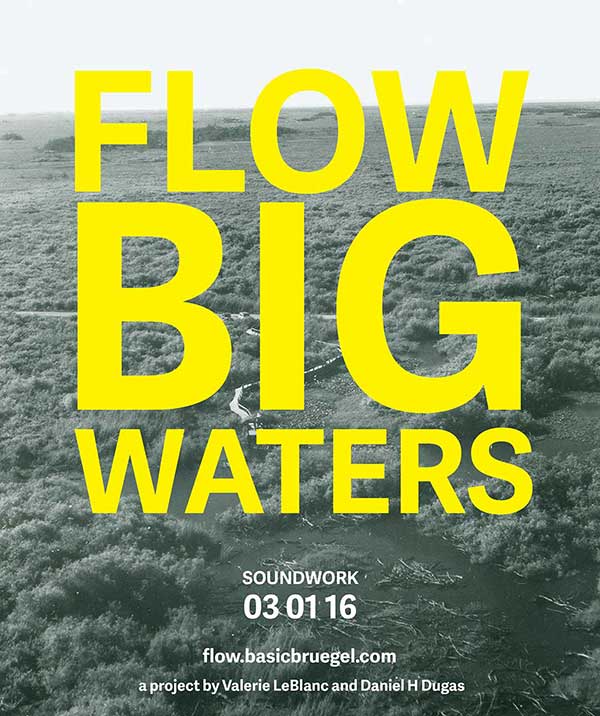
Miami Report – Valerie LeBlanc and Daniel Dugas (2014)
Report from a visit to Miami and the Everglades National Park – Valerie LeBlanc and Daniel Dugas, November 2014
Our visit to South Florida to screen video poetry at the Miami Book Fair International and a visit to the Everglades National Park was short. Aside from the two days of air travel, we were there for just three days, really full days! To begin, on November 18, we screened several videos and took part in a panel discussion on the transformative effects that the July 2014 AIRIE (Artist In Residence In Everglades) residency had on our work. While our FLOW: BIG WATERS everglades-based project is ongoing and will eventually include an installation with soundwalks and photographs, we were happy to screen a selection of the video works that we have completed to this date.
The panel discussion was co-moderated by Artist and AIRIE Executive President, Deborah Mitchell and Biologist Skip Snow. The five AIRIE Artists who presented and took part in the discussion were: Gustavo Matamoros, Reed van Brunschot, Author Anne McCrary Sullivan, and ourselves. After brief introductions by Deborah Mitchell, Miami historian Dr. Paul George opened the conversation with details about the current and recent landmarks that stand and stood close to the Book Fair venue we were sitting within. Downtown Miami is undergoing many physical changes as new buildings replace older structures. Dr. George’s comments brought some of these changes to light. The evening took place at the SWAMP; the pop-up lounge utilized for showcasing social and cultural events during the Miami Book Fair International on the Miami Dade College, Wolfson Campus.
After the AIRIE presentation, Gustavo Matamoros and his partner, Miami-based Graphic Artist Claudia Ariano invited us to drive over to Little Havana’s El Cristo Restaurant to experience Cuban cuisine. The conversations continued in a range of topics that ran from contemporary art through a variety of cultural markers.
During two of our days, we walked around the Wolfson Campus and Miami’s downtown to become somewhat oriented with the city. We found our way over to the Miami Beach Mall for the opening of an umbrella of exhibitions at the ArtCenter of South Florida. The open studios and exhibitions for the 30 Years on the Road show spread out from 924 Lincoln Road, along the block to transform the experience from indoor venues to vitrines for sidewalk viewing. It is an ambitious undertaking that showcases retrospective and contemporary artworks embodying many genres. Outside of 924 Lincoln, the Listening Gallery, in partnership with Subtropics.org is presenting the collaborative work: Walk-Run. On opposite sides of the entrance doors, Walk-Run features face to face moving images by Charles Recher. Combined with a soundscape by Rene Barge and Gustavo Matamoros, Walk-Run can be experienced differently depending on if you are up-close to it, on the sidewalk in front of the building, or at distance. Turning the corner to view other artworks presented in vitrines also permits variable exposure to the audio as the sound waves bend around the architecture of the cityscape. Owing to the nature of showing so many artists at one time, the opening reception moved along the block with conversations continuing inside in and outside of the studios. Walking this stretch of the Mall with Gustavo, we met and talked with many artists. We also took time to view examples of art deco along the Lincoln Road Mall.
On November 20, the final day of our visit, Deborah Mitchell invited us to drive out to the AIRIE lab to visit November’s resident artist Regina Jestrow. Regina had generously organized an open studio reception in the lab where she laid out a sampling of the research she carried out during the month. It was a chance to talk informally with Regina, the other artists and scientists who dropped by, and several of the Park Staff that we had the pleasure of working with during July. We saw the beginning stages of Regina’s artworks utilizing imprinted rubbings and look forward to seeing the next stage of this new textile based work.
Back in Miami the same evening, we visited the Locust Project. Showing in the Main Space is Daniel Arsham’s Welcome to the Future. In the project room,Salvadorian artist Simón Vega’s exhibition Sub-Tropical Social Sculptures is ongoing.We arrived in time for the Art on the Move presentation with Curator Dominic Molon in conversation with Vancouver-based artist Ron Terada. The subject of the discussion was Terada’s Soundtrack for an Exhibition.
Our on-the-ground introduction to the Miami art scene gave us the chance to scratch the surface of this diverse, multicultural city where Spanish is the predominantly spoken second language. Staying in downtown Miami gave us the chance to see the last days of the old Miami Herald Building as it underwent demolition. It will be interesting to go back and see what new masterpiece rises to replace it on Biscayne Bay. If one word could be used to describe the face and evolving culture of Miami, vibrant would fit!



This activity was supported by the New Brunswick Arts Board


And the MBFI / The Swamp

Miami Book Fair International (2014)
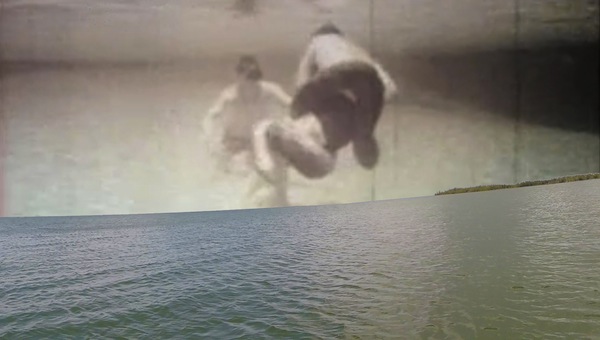
An Evening with AIRIE (Artists in Residence in Everglades)
Miami Bookfair International 2014
Tuesday, November 18th @ 7pm at The Swamp Pavillion
Look for the big tent at the southeast corner of N.E. 3rd Street and 2nd Avenue.
Science + Art: Transformative Experiences in the Everglades
Despite its importance, abundance of wildlife, and great natural beauty, many people have never visited the Everglades and only have a vague idea of it as a tangled swamp rife with pythons, mosquitoes and alligators. AIRIE executive director and artist Deborah Mitchell and biologist Skip Snow will co-moderate a panel of five AIRIE artists on the transformative experience their residency in the Everglades has had on their work. Audio composer Gustavo Matamoros, Visual artist Reed Van Brunschot, author Anne McCrary Sullivan, and multi-disciplinary Canadian artists Valerie LeBlanc and Daniel Dugas will share their recent experiences with the audience while a slide show of AIRIE art provides visual support for their moving narratives.
About the artists
LeBlanc and Dugas will debut their new project FLOW- BIG WATERS with a program of video poems. Based upon their research in the Everglades National Park, the project will continue through 2015 and will also include a series of sound walks and photographs. Researching and recording several aspects of this unique biosphere, this dynamic duo continues working on various aspects of this multi-facetted project. Using tools of writing, still and moving images and audio, the root of their desire is to share the aesthetic joy of being there in the moment. When completed, the project will be available online.
Matamoros will present Bats & Insects, a sound-scape audio composition on exhibit September 19-November 5th at the critically acclaimed Common Ground: Artists in the Everglades at Florida Atlantic University. This Venezuelan composer is the driving force behind ISaw + Subtropics, the leading proponent of experiential music and sound art in the Southeast.
McCrary Sullivan has had poems widely published in literary and academic journals including The Gettysburg Review, the Southern Review, and Harvard Educational Review. During and after her AIRIE residency, she accumulated thousands of hours paddling the waters of the Everglades National Park, which resulted in two books: Ecology II: Throat Song from the Everglades and Paddling the Everglades Wilderness Waterway.
Van Brunschot is a visual artist who uses multiple mediums including sculpture, painting, performance and video. Based on evoking memories of childhood, home life and a general commonality found in nostalgic experiences, her work examines transitions and places them in the public sphere. Van Brunschot will discuss how her recent transformative residency experience has affected her studio practice.
About the Moderators
Biologist Skip Snow worked for the National Park Service for 38 years, the last 25 at Everglades National Park. He has evaluated the effects of water management on park wildlife, worked to reintroduce native species, and spent considerable time working on eradicating the Burmese python. Since retiring in 2013, Skip has been pursuing a keen interest in the intersection of art and science, and continues to volunteer for the park as an emeritus wildlife biologist.
Artist and Executive Director of AIRIE, Deborah Mitchell, participated in the Artist-in-Residence program in Big Cypress in 2007. Since then, environmental awareness and community outreach has been the focus of her multi-disciplinary work. In addition to working with AIRIE fellows and organizing cultural programs, she curated The Preserve in 2012 and Flight: Aloft in the Everglades in 2014. Mitchell’s photographs can be seen in Swamplife, (Minnesota Press).
An evening with AIRIE in the Swamp Pavilion at the Bookfair will be an informative program which presents a nuanced look at the Everglades by letting AIRIE Fellows share their work and perspectives on the park with both local and international book lovers.
http://airie.org/2014/save-the-date-airie-at-the-book-fair-nov-18/
Everglades reverberations (2014)

The following writeup was originally published on the Knight Arts website on July 25th 2014
By Daniel Dugas and Valerie LeBlanc, AIRIE
We came from the north. As we approached Miami, the pilot said something about the weather while swerving to miss storm cells. A few hours later, after we had landed, the downpour started in earnest. The rain was heavy, the sky black. It was a big storm; actually it was the first tropical storm of the 2014 Atlantic Hurricane season. It later strengthened to become Hurricane Arthur and it was tracking northward. Hurricanes often follow the Gulf Stream current and affect the Maritime region of Canada where we live. But this one was going for the jugular; our town was right in the middle of its path. There were a slew of warnings posted on the Environment Canada website, tropical storm, rainfall, wind, special weather statement, and a tropical cyclone information statement. We followed the evolution of Arthur and worried for our house. At the last moment the storm veered left and the town where we live got a good soaking but not the anticipated deluge. It was pretty amazing to arrive in Florida just in time to witness the birth of a storm that slowly moved northward to die almost outside of our doorstep. It was a reminder of the interconnectedness of all things.
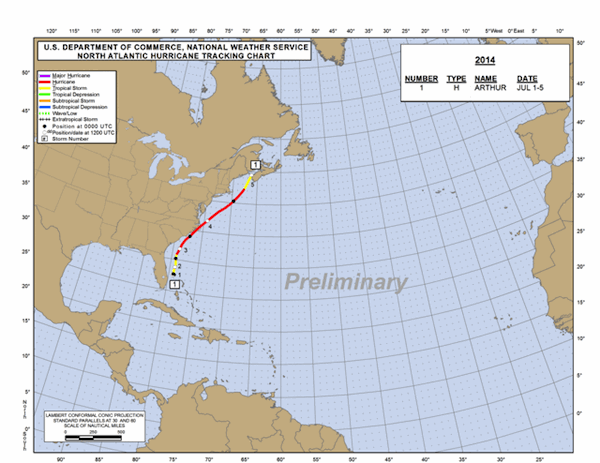 Hurricane Arthur, July 5, 2014, National Hurricane Center
Hurricane Arthur, July 5, 2014, National Hurricane Center
We are here to do a soundwalk project; fictional stories, voices, swamp recordings. It is this concept of interconnectness that is calling for our attention. We are looking at the connections between: the Everglades National Park geography and its inhabitants; those living close to its borders; and those, like ourselves, who come here to commune with the environment. We recognize that ecologically speaking, our understanding and experience of the Everglades is a relatively short moment in time. As we research through the networks and components that is the Everglades, we try to understand something of where it all sits in the grand scheme of things.
Upon arriving, the first thing that we did was to try to visualize the park, to construct a mental chart of what exists where. In the first few days we covered as much ground as we could, recording ambient sound, the weather, and the insects. The mosquitos hit the shotgun mic with anger. We saw sunrises, sunsets, walked in the warm waters of the slough at Pa-Hay-Okee, attempted to hike among the mangroves at Christian Point Trail, immersed ourselves in the song of crickets, frogs, of rustling in the bush, of movement in the trees.
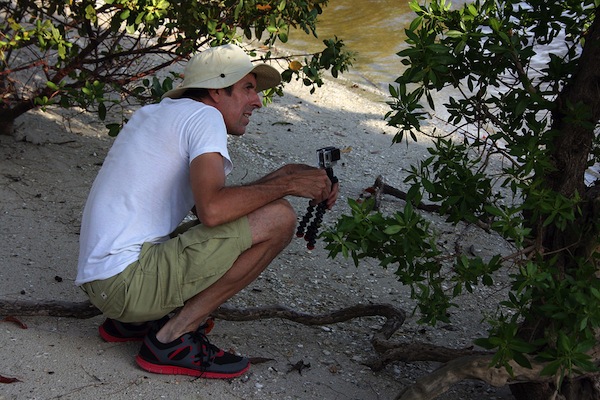 Daniel, Chokoloskee
Daniel, Chokoloskee
The type of collaboration that we do is diverse. We have been collaborating for over twenty years on many projects. Often we work within a framework that allows for individual sensitivities to bubble to the surface, this is the case with our Everglades project. As we go out on hikes and explorations we experience the same location but from two different perspectives. Our individual takes are like stones thrown into a lake; the ripples of both, the points on intersections lie where the waves combine. That is often the place of creation.
Soon after arriving, we realized that we were in a world of layers. That we would have to see through the mosquito layer, the mosquito net layer, the humidity layer, the heat stress layer and the DEET layer. Every task becomes monumental, every clap of thunder, every raindrop intensifies, maximizes the experience.
We quickly learned to operate in the environment, to be there. Because audio recording demands silence and stillness, it is an obvious target for the hordes of skitters. In the spirit of adaptation, Valerie developed a Tai-Chi-like series of movements to repel them away from the microphone pickup area. This slow motioned waving of blue rubber gloved hands became the symbol of a certain level of peace.
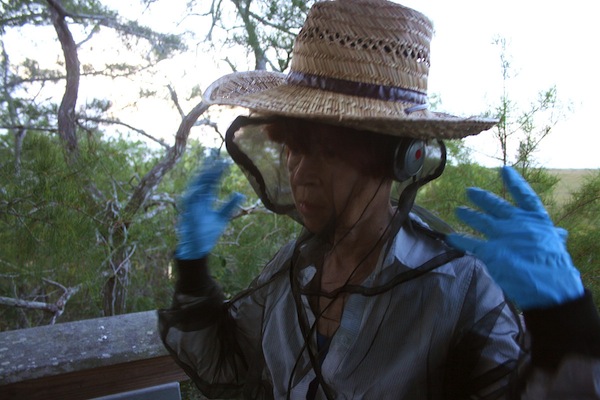 Valerie’s Tai-Chi-like series of movements, Pa-Hay-Okee
Valerie’s Tai-Chi-like series of movements, Pa-Hay-Okee
Of all the layers present within the Park, it is the human presence that has become the focus of our work. Whether it is the recently abandoned Chekika Day Use Area, the HM69 Nike Missile Base,
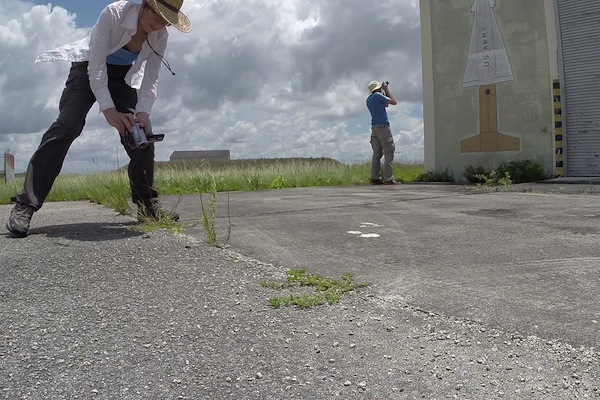 Valerie and Daniel, HM69 Nike Missile Base
Valerie and Daniel, HM69 Nike Missile Base
the shell mounds of the Calusa Indians on Sandfly Island or the Deer Pen ruins near Paradise Key, all of these traces reveal something about human interventions in this place. Trace elements become covered, overgrown, eaten or corroded as plants, animals and climate reclaim. Sites can be seen as momento mori, reminders of mortality, but they are also reverberations of life.
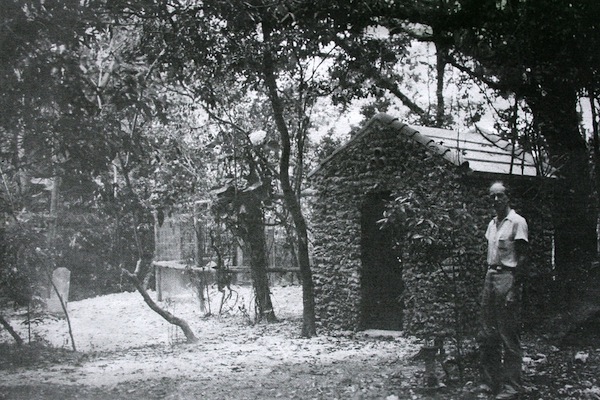 Deer Pen, Paradise Key, NPS archives July, 1934
Deer Pen, Paradise Key, NPS archives July, 1934
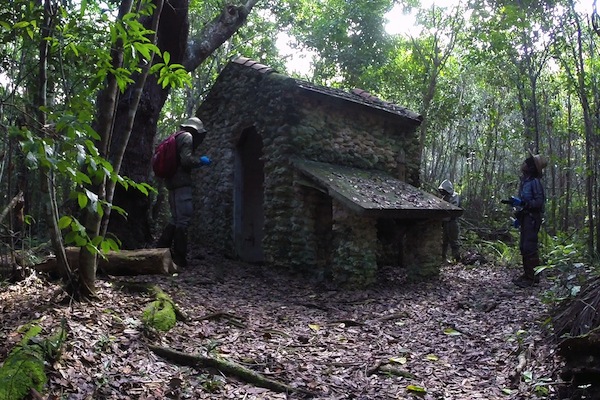 Deer Pen, July 2014, left to right: Daniel Dugas; Hillary Cooley, Botanist, Everglades and Dry Tortugas National Parks and Valerie LeBlanc
Deer Pen, July 2014, left to right: Daniel Dugas; Hillary Cooley, Botanist, Everglades and Dry Tortugas National Parks and Valerie LeBlanc
Announcing 2014 AIRIE Fellows
Valerie LeBlanc and myself are extremely happy to have been invited by the Everglades and Dry Tortugas National Park to be the artists in residence for July 2014. It is a prestigious opportunity and referring to the tradition of invited artists, as stated in the 1st paragraph of the letter, ‘our work there will become part of the permanent record of the parks that helps to preserve them’. Described as a subtropical wilderness, with a unique combination of temperate and tropical characteristics, the Everglades has been designated as a World Heritage Site, an International Biosphere reserve, and a Wetland of International Importance. One of the main outcomes that the Park hopes to gain from the visiting artists is ‘to help visitors make emotional and intellectual connections with this amazing place’. As per our practice(s), we are looking forward to continuing to create poetic storylines within the exploration of this new media locative soundwalk project.
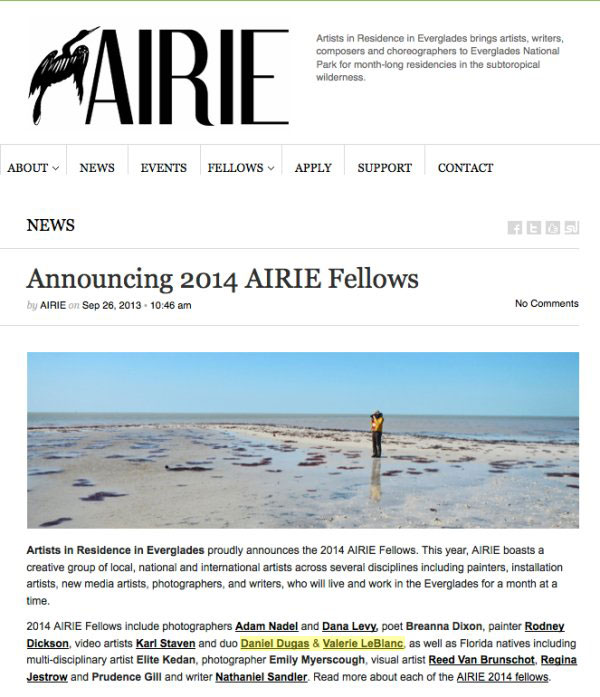
Artists in Residence in Everglades proudly announces the 2014 AIRIE Fellows. This year, AIRIE boasts a creative group of local, national and international artists across several disciplines including painters, installation artists, new media artists, photographers, and writers, who will live and work in the Everglades for a month at a time.
2014 AIRIE Fellows include photographers Adam Nadel and Dana Levy, poet Breanna Dixon, painter Rodney Dickson, video artists Karl Staven and duo Daniel Dugas & Valerie LeBlanc, as well as Florida natives including multi-disciplinary artist Elite Kedan, photographer Emily Myerscough, visual artist Reed Van Brunschot, Regina Jestrow and Prudence Gill and writer Nathaniel Sandler. Read more about each of the AIRIE 2014 fellows.
South Florida is home to the only subtropical wilderness area in the country, AIRIE is the only program bringing artists to the Everglades. AIRIE’s purpose is to inform, connect, and support artists, writers and musicians who wish to be inspired by the Everglades and then become ambassadors for the Park and its resources. AIRIE partners with Everglades National Park staff to offer month-long artist residencies in the Park’s subtropical wilderness. At least twelve AIRIE Fellows per year live and create new work in the Park, and in return lead interactive activities with visitors and donate artwork to the Park.
With generous support from the John S. and James L. Knight Foundation Arts Challenge Grant, AIRIE connects Fellows with the South Florida cultural community to bring attention to this unique and endangered part of our national heritage. AIRIE’s expanded programming will feature a year-round calendar of events both in the Everglades and outside the Park, including readings, performances, workshops and lectures. Through these outreach events, Fellows will use their art forms to engage the public, showcasing the Everglades as inspiring, important and worth protecting.
AIRIE Fellows have the unique opportunity to get to know the ecology of the Everglades by being immersed in it, and then share their perspective through creative public programs. “In a park known for its spectacular and diverse wildlife, the art and voices of AIRIE artists reveal other unique, and often missed, dimensions of this special place,” remarks Park Superintendent Dan Kimball.
from: http://airie.org/2013/announcing-2014-airie-fellow/
Daniel H. Dugas
Archives
Blogroll
- A.I.R. Vallauris
- ACAD
- Adobe additional services
- Adobe Creative Cloud
- AIRIE
- Amaas
- Amazon Author Central
- ARTothèque
- Australian Poetry
- Basic Bruegel
- Bitly
- CCCA
- CDBaby
- Cycling 74
- Dissolution
- Éditions Prise de parole
- Emmedia
- eyelevelgallery
- FAVA
- Festival acadien de poésie
- Festival FRYE Festival
- FILE – Electronic Language International Festival
- Freeware list
- Fringe Online
- Galerie Sans Nom
- Gotta Minute Film Festival
- Instants Vidéo
- JUiCYHEADS
- Kindle Direct Publishing
- Klondike Institute of Art and Culture
- La Maison de la poésie de Montréal
- La Maison de la Poésie et de la Langue française Wallonie-Bruxelles
- Laboratorio Arte-Alameda
- Le Centre Jacques Cartier
- Liberated Words
- Maison Internationale de la Poésie – Arthur Haulot
- MediaPackBoard
- Miami Book Fair International
- Monoskop
- Mot Dit
- NSCAD University
- Paved Arts
- PoetryFilm
- Portail des auteurs du Nouveau-Brunswick
- RECF
- Revue Ancrages
- Salon du Livre du Grand Sudbury
- Sculpture Space
- Subtropics.org
- Sydney college for the arts
- The Centre for Contemporary Canadian Art
- The New Gallery
- Trevigliopoesia
- tumbler-documents
- V Tape
- Valerie LeBlanc
- VideoBardo
- Void Network-Κενο Δίκτυο
Categories
- #covidpoèmes
- Advertisement
- AIRIE
- Ancrages
- anthology
- Anthropocene
- Architecture
- Around Osprey
- art
- Article de presse
- arts visuels
- audio
- Australian Poetry
- Basic Bruegel Editions
- Book
- book fair
- Cafe Poet Program
- Ce qu'on emporte avec nous
- Citations gratuites
- Collaboration
- commentaire
- commentary
- Compte rendu
- conférence
- Conservation Foundation of the Gulf Coast
- COVID-19
- Critique littéraire
- culture
- Daniel Dugas
- Design
- Édition Michel-Henri
- Éditions Perce-Neige
- Éloizes
- Emmedia
- emoji etc | émoji etc
- Environnement
- essai
- essay
- Everglades
- Exhibition
- festival
- Festival acadien de poésie
- Festival Frye Festival
- FIPTR
- Flow: Big Waters
- Fundy
- Habitat
- installation
- Instants Vidéo
- interactivity
- journal
- JUiCYHEADS
- Kisii
- L'Esprit du temps
- laptop
- Leaving São Paulo
- lecture
- Livre
- logos
- Magazine
- Miami Book Fair
- Moncton 24
- novel
- OASIS
- oil spill
- perception
- performance
- Photo
- poésie
- Poetic Licence Week
- Poetry
- politics
- politique
- press
- Prise de parole
- Revue Ancrages
- salon du livre
- sculpture
- Sculpture Space
- sound
- Souvenirs
- Spirit of the Time
- Style & Artifacts
- Symposium d'art/nature
- talk
- television
- The New Gallery
- Uncategorized
- Valerie LeBlanc
- vidéo
- vidéopoésie
- Videopoetr/Vidéopoésie
- videopoetry
- visual arts
- What We Take With Us
- youth literature







